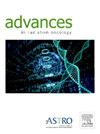High-Dose-Rate Brachytherapy Boost for Prostate Cancer: A Retrospective Observational Study in Low- and Middle-Income Countries
IF 2.7
Q3 ONCOLOGY
引用次数: 0
Abstract
Purpose
Prostate brachytherapy used as an adjunct to external beam radiation therapy is recognized as an effective therapeutic approach in the treatment of intermediate and high-risk prostate cancer. However, data remain limited in African countries, particularly Morocco. The aim of this study was to assess the oncological outcomes and tolerability of boost brachytherapy in a Moroccan cohort.
Methods and Materials
A retrospective study was conducted between 2014 and 2022. Among 128 patients treated with prostate brachytherapy, 106 with intermediate- or high-risk prostate cancer who received high-dose-rate brachytherapy as a boost were included. Hormone therapy was administered to 84.91% of patients. Median follow-up was 26 months. Clinical characteristics, dosimetric data, toxicity, and oncological results were analyzed.
Results
Of the 106 patients, 59 (55.66%) had intermediate-risk cancer and 47 (44.34%) had high-risk cancer. Locally advanced stage (T3a-T3b) was observed in 43.4% of patients. At 3 years, overall survival, metastasis-free survival (MFS), and biochemical progression-free survival (BPFS) were 87%, 92%, and 78%, respectively. The 3-year BPFS was 75% for intermediate-risk cancers and 70% for high-risk cancers. International Society of Urological Pathology (ISUP)scores 1 to 3 showed better BPFS (85%) and MFS (92%) than ISUP scores 4 to 5 (BPFS: 60%, MFS: 79%). Clinical stage was the only significant factor for MFS (P = .001). No grade 3 acute toxicities (genitourinary or gastrointestinal) were reported. Late grade 3 toxicities were observed in 1.89% (genitourinary) and 0.94% (gastrointestinal) of patients. Grade 2 toxicities remained low (<9%).
Conclusions
This single-center study confirms the efficacy and tolerability of the combination of external beam radiation therapy and brachytherapy in the treatment of intermediate- and high-risk prostate cancer. The results are encouraging, even in advanced-stage patients. Clinical stage has been shown to be the main prognostic factor for MFS.
高剂量率近距离放疗促进前列腺癌:中低收入国家的回顾性观察研究
目的前列腺近距离放射辅助治疗是治疗中、高危前列腺癌的有效方法。但是,非洲国家,特别是摩洛哥的数据仍然有限。本研究的目的是评估摩洛哥队列中增强近距离放射治疗的肿瘤学结果和耐受性。方法与材料2014 - 2022年进行回顾性研究。在128名接受前列腺近距离放射治疗的患者中,106名接受高剂量或高风险前列腺癌近距离放射治疗的患者被纳入研究。84.91%的患者接受激素治疗。中位随访时间为26个月。分析了临床特征、剂量学数据、毒性和肿瘤学结果。结果106例患者中,59例(55.66%)为中危癌,47例(44.34%)为高危癌。43.4%的患者为局部晚期(T3a-T3b)。3年时,总生存率、无转移生存率(MFS)和无生化进展生存率(BPFS)分别为87%、92%和78%。中危癌症的3年BPFS为75%,高危癌症为70%。国际泌尿病理学会(ISUP)评分1 ~ 3分显示BPFS(85%)和MFS(92%)优于ISUP评分4 ~ 5分(BPFS: 60%, MFS: 79%)。临床分期是MFS的唯一显著因素(P = 0.001)。没有3级急性毒性(泌尿生殖系统或胃肠道)的报道。晚期3级毒性分别发生在1.89%(泌尿生殖系统)和0.94%(胃肠道)。2级毒性仍然很低(<9%)。结论本单中心研究证实了外束放疗联合近距离放疗治疗中、高危前列腺癌的疗效和耐受性。结果令人鼓舞,即使在晚期患者中也是如此。临床分期已被证明是MFS的主要预后因素。
本文章由计算机程序翻译,如有差异,请以英文原文为准。
求助全文
约1分钟内获得全文
求助全文
来源期刊

Advances in Radiation Oncology
Medicine-Radiology, Nuclear Medicine and Imaging
CiteScore
4.60
自引率
4.30%
发文量
208
审稿时长
98 days
期刊介绍:
The purpose of Advances is to provide information for clinicians who use radiation therapy by publishing: Clinical trial reports and reanalyses. Basic science original reports. Manuscripts examining health services research, comparative and cost effectiveness research, and systematic reviews. Case reports documenting unusual problems and solutions. High quality multi and single institutional series, as well as other novel retrospective hypothesis generating series. Timely critical reviews on important topics in radiation oncology, such as side effects. Articles reporting the natural history of disease and patterns of failure, particularly as they relate to treatment volume delineation. Articles on safety and quality in radiation therapy. Essays on clinical experience. Articles on practice transformation in radiation oncology, in particular: Aspects of health policy that may impact the future practice of radiation oncology. How information technology, such as data analytics and systems innovations, will change radiation oncology practice. Articles on imaging as they relate to radiation therapy treatment.
 求助内容:
求助内容: 应助结果提醒方式:
应助结果提醒方式:


